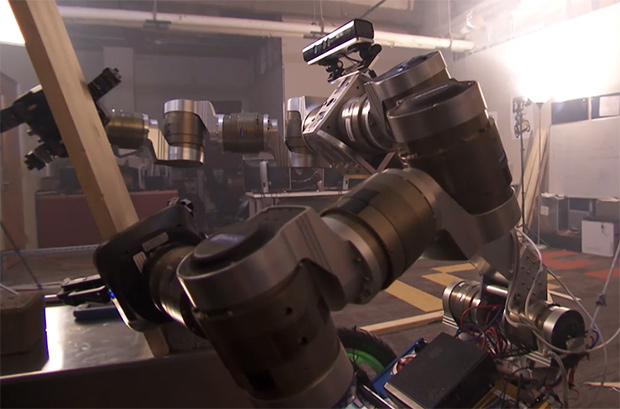Image: Georgia Tech
MacGyver could make a rocket-powered harpoon gun/zip line out of some moth balls, cleaning fluid, rope, pulley, and an old telescope. Robots can’t do that. But hey, neither can you. What you can do is use objects in your environment to help you complete tasks that you wouldn’t otherwise be able to do on your own, and robots are learning how to do the same thing.
Yes, this means that soon they will be unstoppable. And there’s video to prove it.
I didn’t pull the whole MacGyver analogy out of nowhere; it’s in the title of a video submission to the IEEE International Conference on Robotics and Automation (ICRA 2014) from Georgia Tech: “Robots Using Environment Objects as Tools: The ‘MacGyver’ Paradigm for Mobile Manipulation.”
Robots almost universally treat the environment as one giant obstacle that needs to be avoided. But obstacles can be turned into tools, as long as you know what the obstacles are potentially good for. In the video below, Georgia Tech’s Golem Krang robot uses a bunch of stuff that would otherwise be problematic to perform a task:
In this experiment, we design a complete rescue scenario with a 100 kg brick object blocking entry to a room and another 100 kg loaded cart. Interestingly, the loaded cart becomes a fulcrum for an arbitrary board to topple the bricks. Then the bricks, which were initially an obstacle, are used as a fulcrum for a lever to pry open the door. Finally the robot uses a wider board to create a bridge and perform the simulated rescue.
This demo was an evaluation of the robot’s capabilities and potential. A nearby human teleoperator controls the robot, but some of its functions (such as balancing itself as it grasps and uses objects) are autonomous. The idea is that robots will someday be able to tackle problems like this with greater autonomy.
In a second paper presented at ICRA, the researchers taught a humanoid robot to traverse a gap by finding, and then implementing, an object in its environment.
To achieve such behavior, we introduce the concept of EnvironmenT Aware Planning (ETAP). ETAP lets the robot reason about tapping into resources available in the environment to complete its task. ETAP gives a robot the capability to use objects in its environment to assist its locomotion capabilities.
The gap between the platforms was too wide for the robot to step over. The constraint relaxed planning steps determined that the robot needs to cross the gap in order to reach the goal. The planning system then guided the robot to pick up the board and drop it across both platforms. The planner picked the board as it was longer than the gap. Additionally, the board only required 8 cm on each side to be placed on flat ground if dropped. This allowed the robot to drop it across both platforms. After the robot verified that it could reach the goal given the new environment configuration, the robot stepped over the board and reached its goal configuration.
In this case, the robot (HRP-2) already knew about the board, and what it could be used for (like, it knew that the board could support its weight), but the planner did all of the MacGyvering. The overall idea is that you can give a robot an objective, and it’ll figure out on its own how to complete that objective, using whatever is available to it.
Like we said, unstoppable.
“Robots Using Environment Objects as Tools: The ‘MacGyver’ Paradigm for Mobile Manipulation,” by Mike Stilman, Can Erdogan, Saul Reynolds-Haertle, Munzir Zafar, Peng Hou, and Gregory Tracy, and “Autonomous Environment Manipulation to Assist Humanoid Locomotion,” by Martin Levihn, Koichi Nishiwaki, Satoshi Kagami, and Mike Stilman, from Georgia Tech and AIST, were presented last month at ICRA 2014 in Hong Kong.
Mike Stilman, founder of Georgia Tech’s Humanoid Robotics Lab, passed away in May. We’re terribly sorry for this loss to Mike’s family, friends, and the robotics community. The Humanoid Robotics Lab website is a memorial for Mike right now, which you can see here.

